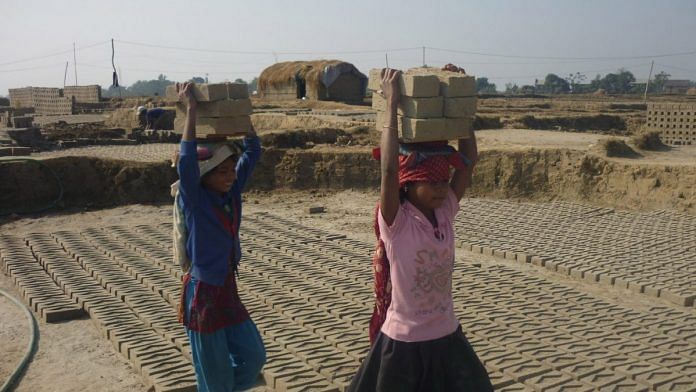New Delhi: A new report has found that a five-year intervention campaign by 45 Indian NGOs that were backed by Freedom Fund has effectively reduced unfair labour practices in Uttar Pradesh, Bihar and Tamil Nadu by nearly 80 per cent.
The report, titled ‘Unlocking what works: How community-based interventions are ending bonded labour in India’, says the intervention campaign had cut the percentage of families in bondage from 56 per cent (at baseline) to 11 per cent (endline) in the three states. For its programme, the London-based NGO Freedom Fund had identified 1,100 villages or “hotspots” in India where bonded labour practices were most prevalent.
The organisation invested $15 million in 45 frontline NGOs in India between 2014 and 2019 to conduct “direct, on-the-ground interventions to free workers from debt bondage and other forced labour conditions”. A total of 1,40,000 households were targeted across the three states.
Yuki Lo, senior research and evaluation manager of Freedom Fund, told ThePrint that the hotspot model was a way of directing resources “into the most vulnerable communities, investing in local frontline organisations to protect communities from exploitation, liberate and rehabilitate survivors, and ensure the prosecution of perpetrators”.
There are multiple external evaluations of Freedom Fund’s intervention, including one by the Harvard University’s FXB Center for Health and Human Rights and the UK Home Office. All of these have concluded that besides a significant reduction in bonded labour, the target areas also showed a marked reduction of household debt and increased savings.
Freedom Fund had also invested in other studies in India to examine the root causes of bonded labour and child labour, highlight the gaps in prosecuting offenders and protecting victims of exploitation.
Also read: Pre-poll Budget session must pass minimum wage for unorganised labour
Families in bondage fell from 13% to 1% in Tamil Nadu
The reduction of families in bondage from 56 per cent (or roughly 79,000 households) to 11 per cent (or roughly 17,000 households) across the three states also meant an equivalent of 62,000 households or 1,25,000 individuals leaving debt bondage as a result of these grassroots interventions.
While Freedom Fund partnered with 25 NGOs in Uttar Pradesh and Bihar, they worked with 20 in Tamil Nadu. The areas selected were those that are subject to “intense economic deprivation and are exposed to a host of exploitative labour practices in local agriculture, brick, stone and carpet industries”.
“Families from economically isolated and socially excluded backgrounds, such as those from Dalit or other scheduled castes, are particularly at risk of debt bondage,” the report says.
The NGOs targeted 70,000 households in the hotspot areas of Uttar Pradesh and Bihar. And the percentage of households (with a child) in bonded labour fell from 12 per cent to 3 per cent, or from 8,400 households to 2,100 households.
In Tamil Nadu, the study notes, spinning mills and handloom units are the most prevalent sites of debt bondage where young women and girls, aged between 14 and 20 years, make up a significant part of the workforce. The NGOs targeted 70,000 households in the state and witnessed a reduction of 13 per cent to 1 per cent of families (with a child) in bondage.
In southern India again, the interventions led to a reduction in child marriages and school dropouts by more than half between 2016 and 2018.
Also read: Despite wage increase, number of working women in India fell between 1983 & 2011, says study
Last central govt survey of bonded labour in 1978
While the Freedom Fund had based its ‘before intervention’ figures from the Institute of Development Studies (part of the University of Sussex), there is no official government data on bonded labour in India.
In May 2013, the UPA government had claimed that bonded labour no longer existed — thanks to the MGNREGA scheme. But this claim was widely contested by civil rights organisations.
The last survey done by any government in India was in 1978, in which 3,43,000 people were found to have been engaged in bonded labour across 16 states of the country.
Households saved 55% more with intervention
Harvard’s FXB Center for Health and Human Rights also found that Freedom Fund and its cluster NGOs helped targeted households save 55 per cent more. It also noted that these families saw a 31 per cent faster wage growth compared to other communities.
“The intervention led to reduced household debt, increased household savings, higher wage growth, increased access to medical care, increased use of government schemes and improved household food security,” the Harvard University evaluators noted.
Some of the tactics adopted by NGOs for debt reduction included creating community groups that acted as alternative sources of loan for members and financial self-help groups comprising of adolescent girls and women to fight gender-specific exploitation.
The organisations further inspired individuals to challenge violations in their workplaces by creating community vigilance committees, internal complaint committees where workers can address grievances and courses to inform workers of their rights and recourse under law.
Also read: Are conversations between husbands and wives keeping rural Indian women from working?



